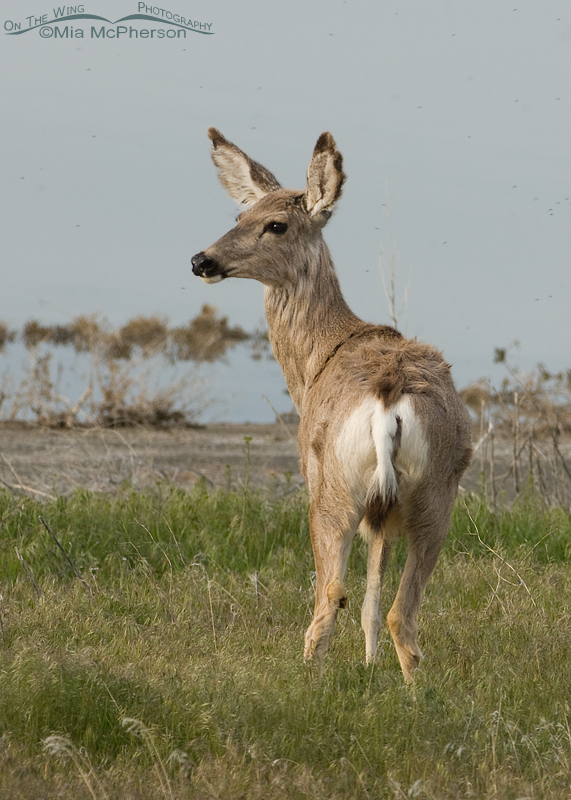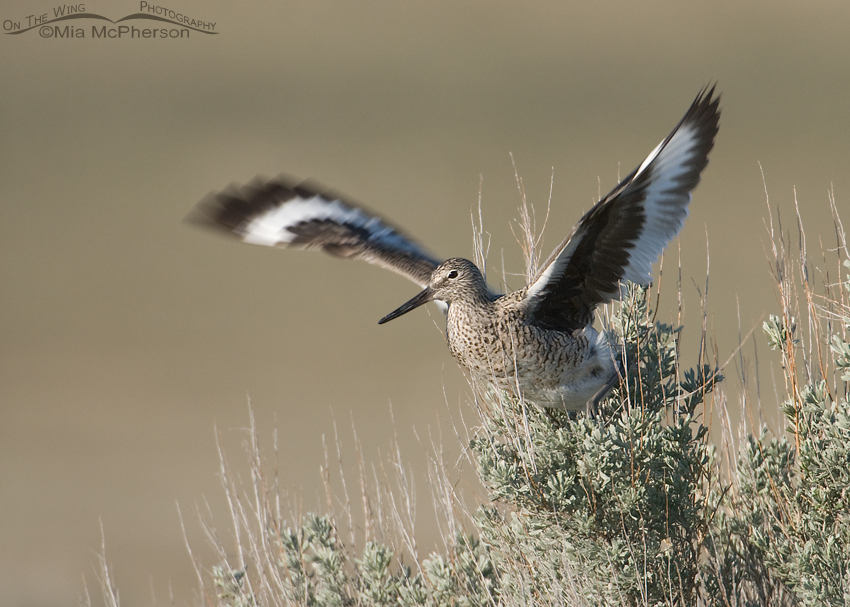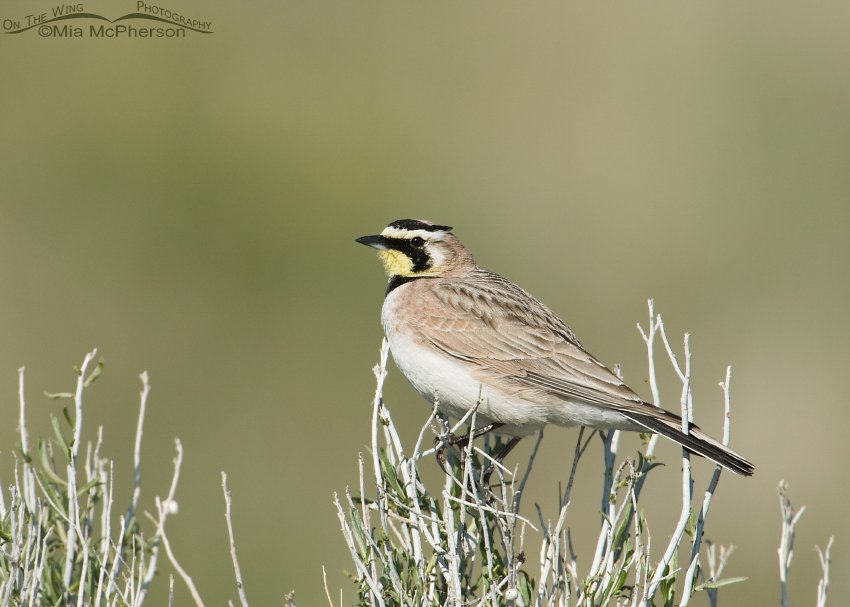 Mule Deer doe on the Antelope Island Causeway – Nikon D200, f6.3, 1/160, ISO 400, +0.7 EV, Nikkor 200-400mm with 1.4x TC at 220mm, natural light
Mule Deer doe on the Antelope Island Causeway – Nikon D200, f6.3, 1/160, ISO 400, +0.7 EV, Nikkor 200-400mm with 1.4x TC at 220mm, natural light
Last week I spent some time camping in southern Utah hoping to find birds to photograph. Well it did not pan out as far as birds go (a little too early in the year for the species I wanted to photograph) but the scenery, weather and the company was fantastic.
The next day after returning to Salt Lake due to the lack of birds I headed to Antelope Island State Park where the birds are not lacking. I admit, I was having “withdrawals, I needed a bird fix.
On the causeway the Mule Deer was running away from the island, I should have known it might have had a reason to do that. The doe paused long enough for a few photos then on towards the island I went.
 Willet lift off – Nikon D200, f6.3, 1/750, ISO 400, Nikkor 200-400mm VR with 1.4x TC at 400mm, natural light
Willet lift off – Nikon D200, f6.3, 1/750, ISO 400, Nikkor 200-400mm VR with 1.4x TC at 400mm, natural light
The first bird close enough to photograph was a Chukar (common on the island), I got the window rolled down and rested my lens on my noodle and got ready to photograph the bird.
Almost immediately I could feel a stinging sensation on my cheek, then my hairline followed by my wrist. I groaned “The Antelope Island gnats are back!”. It is amazing how much difference a few days can make. The biting gnats come out around the end of April on Antelope Island and they last for weeks. And weeks. For what seems to be years.
They are tiny, little buggers but their bites are big. They don’t take a huge chunk out of you or anything but the bites do make their presence known. I’d written about the need to “Buy cases of insect repellent” in a bird photography blog post here in February and maybe people thought I was joking but you do need those cases of insect repellent for those biting gnats. Even after using the repellent those nasty gnats still find unprotected areas to bite. They are a scourge. After the biting gnats appear there are signs at the park entrance noting the presence of gnats and just how bad they are. “Biting gnats are present” and “Biting gnats are very bad”.
 Male Horned Lark on Rabbitbrush – Nikon D200, f7.1, 1/1000, ISO 400, Nikkor 200-400mm VR with 1.4x TC at 400mm, natural light
Male Horned Lark on Rabbitbrush – Nikon D200, f7.1, 1/1000, ISO 400, Nikkor 200-400mm VR with 1.4x TC at 400mm, natural light
So, just at the time of year when the Pronghorns and the Bison will have their young, the Willets are returning to call on the rocks, when Black-billed Magpie chicks should be hatching, when the Long-billed Curlews are on their nests and bird activity really picks up on the island… the biting gnats come back.
If you have never been bitten by the gnats on Antelope Island, thank your lucky stars and be glad. The itching doesn’t start right away but when it does, you will sure know it! I have to wonder if the gnats bite the birds and animals on the island or if they just prefer humans.
I hereby put the millions of biting gnats on Antelope Island on notice: No matter how many times you break through my insect repellent shield, I am still going to photograph birds on Antelope Island. No matter how much you make me itch or make me gasp from the fumes of the bug juice, I am still going to show up on the island. You might bug me (literally) but you won’t stop me either. And every chance I get I will squash the snot right out of you. You can bite me but you won’t win!
The biting gnats seem to go away once the temperatures hit the 90 degree mark, not soon enough if you ask me.
I wonder if Calamine lotion would help with the itching in my scalp? Pink hair does seem to be in fashion…
Yes, I am addicted to bird photography.
Mia


Oh my gosh. You’re too funny. I understand. My husband and I go to the island all the time.
And we use a lot of OFF. They don’t keep us away. And like you said…..those darn bugs will find that one spot you missed!
Your photos are outstanding!
Judy, I’m sure not looking forward to dealing with the biting gnats this coming spring, but battle I will because I won’t allow them to stop me from photographing the birds & critters! Maybe a clove of garlic around the neck will work. Or get a spray tanning booth and substitute bug repellent for that tanning liquid!
Thanks for your kinds words on my images.
Mia-I am completely sympathetic. Whether it’s gnats, mosquitoes, or deer flies I attract them instantly. I actually bought a “bug suit” from Cabelas that’s very light weight, camouflaged, and quite rugged, but I’ve yet to put the pests on notice as you have. I’ll make that declaration when I’m out next!
Well, you got some nice photos out of your torture session. I like the coloring on the Horned Lark, and it seems strange to see a Willet in sagebrush, I have only seen them on beaches. Are those the terrorist gnats called “no see ums”? I’m itching just thinking about it! I hope they will be gone by October.
I’m addicted to bird photography too. I walked around in a field of high grasses last saturday morning for hours and brought home about 15 ticks-which creeped me out-then went back the next day and did the same thing! It was worth it because I got 4 new species. No ticks on Sunday though-because I took precautions and suited up properly.
Julie, I think what they call biting gnats on the island are “no-see-ums”, I just know they can sure make a person miserable. They usually disappear when the temps reach the 90’s, you won’t have to worry about them in October. Congrats on the four new species even with the ticks. It is amazing what bird photographers put up with to “feed” their bird addictions!
The first time I saw Willets in Utah I was freaked out seeing them high on rocks and on the grassy plains! I was so used to seeing them on beaches and spartina marshes. The same with long-billed curlews.